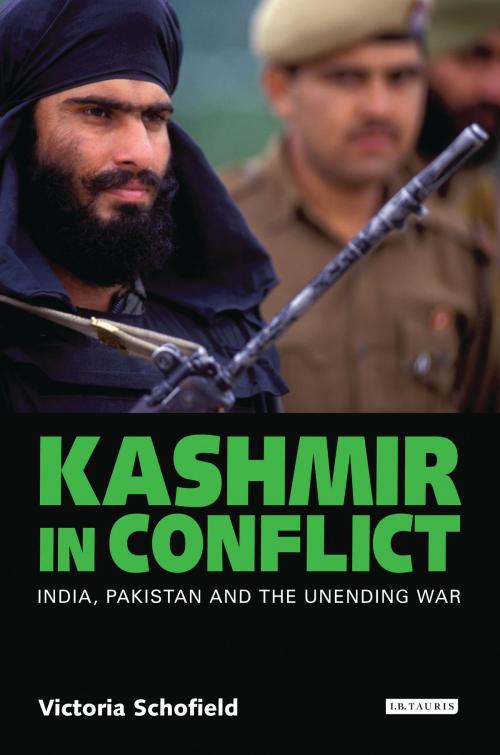Kashmir in Conflict
India, Pakistan and the Unending War
Nonfiction, Social & Cultural Studies, Political Science, International, International Security, History| Author: | Victoria Schofield | ISBN: | 9780857730787 |
| Publisher: | Bloomsbury Publishing | Publication: | May 30, 2010 |
| Imprint: | I.B. Tauris | Language: | English |
| Author: | Victoria Schofield |
| ISBN: | 9780857730787 |
| Publisher: | Bloomsbury Publishing |
| Publication: | May 30, 2010 |
| Imprint: | I.B. Tauris |
| Language: | English |
After 20 years of insurgency, Kashmir continues to be a major flashpoint and decisive factorin destabilising regional relations. Resolving the dispute over the state of Jammu andKashmir is crucial to achieving peace and stability, without which the US Af-Pak strategy isunlikely to succeed. With international eyes focused on South Asia, understanding what is atstake in Kashmir has never been more important. For decades, the dispute over the valley of Kashmir, famed for its beauty and tranquility, has determined much of Pakistan's and India'sforeign policy. With the state, located between two nuclear armed states and India blaming Pakistani militants for the 2008 terrorist attacks on Mumbai, the potential widerimplications of the conflict are higher than ever on the international agenda.
Kashmir in Conflict offers a highly readable, carefully documented account of the origins,development and implications of this contentious issue. Beginning with the early history ofthe independent kingdom of Kashmir, Victoria Schofield traces the origins of the modernstate in the nineteenth century, including the controversial 'sale' by the British ofpredominantly Muslim Kashmir to a Hindu ruler. She examines the implications for thepeople when in 1947 the Maharaja chose secular, yet majority Hindu, India over Muslim Pakistan and shows why the neighbouring countries continue to argue over the status ofJammu and Kashmir which, according to recommendations passed by the UN, was to bedetermined by the will of the people.
Drawing upon research in the state of Jammu and Kashmir, India, Pakistan, and a range ofhistorical sources, Schofield analyses critically the actions of the key players who, throughoutits history, have contributed to the current militarisation of the valley. And with the help ofnumerous interviews she takes into account the hopes and fears of all the interested parties – Pakistan, India and the people of Jammu and Kashmir who are themselves divided, not onlyby their linguistic and cultural traditions, but also in their objectives.
After 20 years of insurgency, Kashmir continues to be a major flashpoint and decisive factorin destabilising regional relations. Resolving the dispute over the state of Jammu andKashmir is crucial to achieving peace and stability, without which the US Af-Pak strategy isunlikely to succeed. With international eyes focused on South Asia, understanding what is atstake in Kashmir has never been more important. For decades, the dispute over the valley of Kashmir, famed for its beauty and tranquility, has determined much of Pakistan's and India'sforeign policy. With the state, located between two nuclear armed states and India blaming Pakistani militants for the 2008 terrorist attacks on Mumbai, the potential widerimplications of the conflict are higher than ever on the international agenda.
Kashmir in Conflict offers a highly readable, carefully documented account of the origins,development and implications of this contentious issue. Beginning with the early history ofthe independent kingdom of Kashmir, Victoria Schofield traces the origins of the modernstate in the nineteenth century, including the controversial 'sale' by the British ofpredominantly Muslim Kashmir to a Hindu ruler. She examines the implications for thepeople when in 1947 the Maharaja chose secular, yet majority Hindu, India over Muslim Pakistan and shows why the neighbouring countries continue to argue over the status ofJammu and Kashmir which, according to recommendations passed by the UN, was to bedetermined by the will of the people.
Drawing upon research in the state of Jammu and Kashmir, India, Pakistan, and a range ofhistorical sources, Schofield analyses critically the actions of the key players who, throughoutits history, have contributed to the current militarisation of the valley. And with the help ofnumerous interviews she takes into account the hopes and fears of all the interested parties – Pakistan, India and the people of Jammu and Kashmir who are themselves divided, not onlyby their linguistic and cultural traditions, but also in their objectives.















